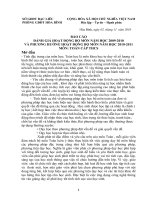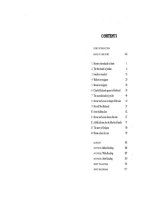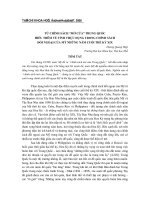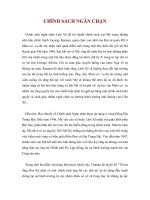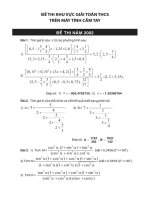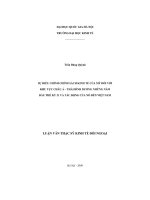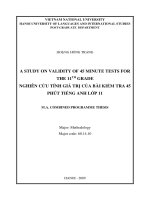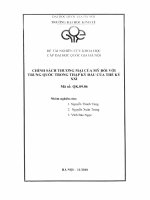figuring all the angles grade 6 Bộ Sách Toán THCS Của Mỹ
Bạn đang xem bản rút gọn của tài liệu. Xem và tải ngay bản đầy đủ của tài liệu tại đây (9.65 MB, 64 trang )
Figuring All
the Angles
Geometry and
Measurement
CuuDuongThanCong.com
/>
Mathematics in Context is a comprehensive curriculum for the middle grades.
It was developed in 1991 through 1997 in collaboration with the Wisconsin Center
for Education Research, School of Education, University of Wisconsin-Madison and
the Freudenthal Institute at the University of Utrecht, The Netherlands, with the
support of the National Science Foundation Grant No. 9054928.
The revision of the curriculum was carried out in 2003 through 2005, with the
support of the National Science Foundation Grant No. ESI 0137414.
National Science Foundation
Opinions expressed are those of the authors
and not necessarily those of the Foundation.
deLange, J.,van Reeuwijk, M., Feijs, E., Middleton, J. A., and Pligge, M. A. (2006).
Figuring all the angles. In Wisconsin Center for Education Research &
Freudenthal Institute (Eds.), Mathematics in Context. Chicago: Encyclopædia
Britannica, Inc.
Copyright © 2006 Encyclopædia Britannica, Inc.
All rights reserved.
Printed in the United States of America.
This work is protected under current U.S. copyright laws, and the performance,
display, and other applicable uses of it are governed by those laws. Any uses not
in conformity with the U.S. copyright statute are prohibited without our express
written permission, including but not limited to duplication, adaptation, and
transmission by television or other devices or processes. For more information
regarding a license, write Encyclopædia Britannica, Inc., 331 North LaSalle Street,
Chicago, Illinois 60610.
ISBN 0-03-039622-0
2 3 4 5 6 073 09 08 07 06
CuuDuongThanCong.com
/>
The Mathematics in Context Development Team
Development 1991–1997
The initial version of Figuring All the Angles was developed by Jan deLange,
Martin van Reeuwijk, and Els Feijs. It was adapted for use in American schools
by James A. Middleton, and Margaret A. Pligge.
Wisconsin Center for Education
Freudenthal Institute Staff
Research Staff
Thomas A. Romberg
Joan Daniels Pedro
Jan de Lange
Director
Assistant to the Director
Director
Gail Burrill
Margaret R. Meyer
Els Feijs
Martin van Reeuwijk
Coordinator
Coordinator
Coordinator
Coordinator
Sherian Foster
James A, Middleton
Jasmina Milinkovic
Margaret A. Pligge
Mary C. Shafer
Julia A. Shew
Aaron N. Simon
Marvin Smith
Stephanie Z. Smith
Mary S. Spence
Mieke Abels
Nina Boswinkel
Frans van Galen
Koeno Gravemeijer
Marja van den
Heuvel-Panhuizen
Jan Auke de Jong
Vincent Jonker
Ronald Keijzer
Martin Kindt
Jansie Niehaus
Nanda Querelle
Anton Roodhardt
Leen Streefland
Adri Treffers
Monica Wijers
Astrid de Wild
Project Staff
Jonathan Brendefur
Laura Brinker
James Browne
Jack Burrill
Rose Byrd
Peter Christiansen
Barbara Clarke
Doug Clarke
Beth R. Cole
Fae Dremock
Mary Ann Fix
Revision 2003–2005
The revised version of Figuring All The Angles was developed by Els Feijs and Jan de Lange. It was
adapted for use in American Schools by Margaret A. Pligge.
Wisconsin Center for Education
Freudenthal Institute Staff
Research Staff
Thomas A. Romberg
David C. Webb
Jan de Lange
Truus Dekker
Director
Coordinator
Director
Coordinator
Gail Burrill
Margaret A. Pligge
Mieke Abels
Monica Wijers
Editorial Coordinator
Editorial Coordinator
Content Coordinator
Content Coordinator
Margaret R. Meyer
Anne Park
Bryna Rappaport
Kathleen A. Steele
Ana C. Stephens
Candace Ulmer
Jill Vettrus
Arthur Bakker
Peter Boon
Els Feijs
Dédé de Haan
Martin Kindt
Nathalie Kuijpers
Huub Nilwik
Sonia Palha
Nanda Querelle
Martin van Reeuwijk
Project Staff
Sarah Ailts
Beth R. Cole
Erin Hazlett
Teri Hedges
Karen Hoiberg
Carrie Johnson
Jean Krusi
Elaine McGrath
CuuDuongThanCong.com
/>
(c) 2006 Encyclopædia Britannica, Inc. Mathematics in Context and the
Mathematics in Context Logo are registered trademarks of Encyclopædia
Britannica, Inc.
Cover photo credits: (left to right) © Comstock Images; © Corbis; © Getty Images
Illustrations
1 James Alexander; 8, 9 Holly Cooper-Olds; 26 Jerry Kraus/© Encyclopædia Britannica,
Inc.; 34 © Encyclopædia Britannica, Inc.
Photographs
3 © Corbis; 4 © Charles E. Rotkin/Corbis; 14 © Corbis; 17 © Roger Ressmeyer/Corbis;
21 (top) © Tim Boyle/Newsmaker/Getty Images; (bottom) © PhotoLink/PhotoDisc/
Getty Images; 23 ImageGap/Alamy; 26 © Corbis; 28 © PhotoDisc/Getty Images;
30 © Corbis; 42 (top) Historic Urban Plans, Inc.; (bottom) Design Pics; 43 ©PhotoDisc/
Getty Images
CuuDuongThanCong.com
/>
Contents
A Sense of Direction
0
20
340
31
0
30
0
290
70
80
270 280
60
E
N
260
100
110
12
0
0
0
24
250
S
15
160
170
180 190
0
23
SW
13
0
8
9
10
11
12
12
90
E
W
0
0
200
22
21
Directions
San Francisco Bay Area
Sun Island
Summary
Check Your Work
Section D
40
SE
Section C
30
50
Finding Your Way
Sunray (1850)
Sunray (1900)
Sunray Today
Downtown Provo, Utah
Summary
Check Your Work
20
W
N
Section B
1
6
6
10
N
3
Getting Your Sense of Direction
Summary
Check Your Work
0
350
33
0
Section A
vi
14
Letter to the Student
14
18
20
20
Navigation and Orientation
Traffic Control
Summary
Check Your Work
21
24
24
Changing Directions: Turns
Section E
Flight Instructions
Plane Landing Activity
Summary
Check Your Work
26
31
32
32
From Turns to Angles
Sled Tracks
Regular Polygons
Summary
Check Your Work
N
Angles and Their Measures
40
0
14
0
52
30
Answers to Check Your Work
15
46
1
20
Additional Practice
80 90 100 1
10
70
80
100
12
70
60 110
0
20
60 13
50 0 1
50 0
3
4
38
40
42
44
45
0
170 180
160
0
0
15
20 10
0
30
14 0
Angles
Measures of Angles
Palmanova
Summary
Check Your Work
10
Section G
33
35
36
36
180 170
160
Section F
Q
Contents v
CuuDuongThanCong.com
/>
Dear Student,
Welcome to the unit Figuring All the Angles.
In this unit, you will learn how planes and
boats navigate their way around the globe.
You will build upon the cardinal directions of
north, east, south, and west to give a better
indication of where you want to go.
Along the way, you will pay close attention to the turns made along a
route. Turns relate to angles, and you will use these to solve some
geometry problems involving shapes.
Sincerely,
The Mathematics in Context Development Team
N
W
E
S
airport
bridge
0
5
5
10 miles
10
16 km
Map from the Road Atlas © 1994 by Rand McNally.
vi Figuring All The Angles
CuuDuongThanCong.com
/>
A
A Sense of Direction
Getting Your Sense of Direction
1. Point toward north. Is everyone in your class pointing in the same
direction?
2. a. Sketch a top view of your classroom. Include the desktops in
your sketch. Draw an arrow pointing north on each of the desks.
b. Do all the arrows point in the same direction?
c. Will lines from the arrows ever meet?
3. In what direction is south?
4. The position of the sun in the sky is related to the direction south.
Record the sun’s position in the sky before noon, at noon, and
after noon.
5. In which direction from the classroom is your school’s playground?
6. Name a town about 50 miles away and point in the direction of
that town. Describe this direction.
7. If you traveled north from your school, which towns would you
pass through?
Section A: A Sense of Direction 1
CuuDuongThanCong.com
/>
A A Sense of Direction
Use a compass to answer problems 8 and 9.
N
W
8. a. Sketch the room where you sleep. Be sure to
include windows in your sketch.
b. Designate where north is in the sketch.
E
9. Compare the sketches of all the students in your
class. Count how many of the windows in the
sketches face south.
S
Here is a partial map of the United States to answer the next questions.
N
W
E
S
Mt. Rushmore
Monument
Valley
West Virginia
0
400 miles
0 400 kilometers
2 Figuring All The Angles
CuuDuongThanCong.com
/>
A Sense of Direction A
Monument Valley, in Arizona, has many spires and mesas that did not
erode as fast as the land around them. You may have seen the picture
above in Western movies. Western movies often describe how the
West was settled.
10. Why is the West called the West?
On one side of Mount Rushmore,
the heads of four United States
presidents have been carved out of
the mountain. Mount Rushmore is
located in South Dakota.
11. Is South Dakota in the South?
Why is it called South Dakota?
You have probably read about the North Pole.
12. Explain why the word North in North Pole has a different meaning
from West in West Virginia. (West Virginia is labeled on the partial
map of the United States on page 2.)
Section A: A Sense of Direction 3
CuuDuongThanCong.com
/>
A A Sense of Direction
The state capitol of Wisconsin is
located in Madison. The capitol
building is unusual because of the
four identical wings radiating from
the huge central dome.
The four wings of the building point in the four compass directions:
north, south, east, and west.
S
O
U
T
H
The south wing is indicated in the drawing below.
13. Label the directions of the remaining three wings on Student
Activity Sheet 1.
4 Figuring All The Angles
CuuDuongThanCong.com
/>
A Sense of Direction A
Hamilton Street
This map of the area around the capitol
building in Madison shows streets going
from north to south and from east to west.
14. Fill in the two missing compass directions
on Student Activity Sheet 1.
King Street
Hamilton Street
State Street
The map of the state capitol looks very much
like a compass used by sailors. As you can
see, there are more than four directions.
NW
N
(Northwest)
?
W
E
?
S
SE
(Southeast)
In Madison, many streets do not run north–south or east–west.
15. Explain why some of the roads in Madison are going southwest–
northeast instead of north–south or east–west?
ve
.
M
ai
n
St
.
A
n
to
ng
hi
as
N
King St.
Hamilton St.
W
as
hi
ng
to
n
A
ve
.
State St.
W
Hamilton St.
Lake
Mendota
W
E
S
Lake
Monona
Section A: A Sense of Direction 5
CuuDuongThanCong.com
/>
A A Sense of Direction
North, south, east, and west are directions you can use to find places
on a map and in the real world. You can combine them to be more
specific; for example, you can say northeast, northwest, southeast,
and southwest.
Directions are relative. For example, South Dakota is not in the South,
but it is south of North Dakota. West Virginia is in the eastern United
States, but it is west of Virginia.
The North Pole is a unique place on earth.
1. Why is it unique? Name another unique place on earth.
2. How would you describe the positions of Hawaii and Alaska
relative to the United States mainland?
Arctic Ocean
Alaska
ASIA
NORTH AMERICA
EUROPE
Pacific Ocean
Atlantic Ocean
Pacific Ocean
AFRICA
Hawaii
N
W
Indian Ocean
SOUTH
AMERICA
AUSTRALIA
E
S
ANTARCTICA
6 Figuring All The Angles
CuuDuongThanCong.com
/>
3. How would you describe the position of South America in
relation to Europe?
4. Describe the position of South America relative to Australia.
Name at least five more locations—inside or outside the US—with
names that relate to compass directions.
Section A: A Sense of Direction 7
CuuDuongThanCong.com
/>
B
Finding Your Way
Sunray (1850)
Small towns often develop along a single road. In Sunray, the first road
was called Main Street. Like many towns, Sunray developed in the
mid–1800s, when the population of the United States was shifting from
the East to the West.
Soon the city expanded and needed more streets. New streets were
built either parallel or perpendicular to Main Street. The roads
perpendicular to Main Street were called avenues.
1. Draw a map of Sunray with three streets north of Main Street,
two streets south of Main Street, two avenues west of Lincoln
Avenue, and three avenues east of Lincoln Avenue.
2. a. Why is it convenient to have the avenues run north–south
when the streets run east–west?
b. How are the streets named in the town where you go to
school?
8 Figuring All The Angles
CuuDuongThanCong.com
/>
Finding Your Way B
Sunray (1900)
Crystal’s house
7th St. N.
Reggie’s house
Town Hall
1st St. N.
Main St.
Sunray has grown. It has many streets
and avenues. The plan of the city looks
like a grid—a combination of horizontal
and vertical lines.
Crystal lives at the corner of 7th Street
North and 6th Avenue West. Reggie
lives at the corner of 3rd Street North
and 3rd Avenue West.
6th Ave. W. 1st Ave. W. Lincoln Ave.
Use a copy of this grid on Student Activity Sheet 2 to help you
answer the problems below.
3. Crystal and Reggie are friends. If Crystal wants to visit Reggie at
his house, how many blocks will she have to walk?
Crystal and Reggie plan to meet each other
for lunch. They like both Tony’s Tortellini on
the corner of Main Street and 7th Avenue West
and Ella’s Deli on 5th Street North and Lincoln
Avenue.
4. Which restaurant is closer to their homes?
The city will build a theater three blocks south
of Main Street. The contractor has a choice of
different building sites, all between 3rd Avenue
East and 5th Avenue West.
5. a. How far (in number of blocks) from
Crystal’s house could the theater be
built?
b. Which location would be closest to
Crystal’s house?
Section B: Finding Your Way 9
CuuDuongThanCong.com
/>
B Finding Your Way
65th Ave. East
40th Ave. East
Lincoln Ave.
60th Ave. West
Sunray Today
Here is a map of Sunray as it looks now.
D
80th St. North
You will now use a scale line on a map to
find a distance. Many maps have scale
lines. The scale line on the map of Sun Ray
shows 10 miles.
E
6. On the map’s scale, what distance is
indicated by each hatch mark?
40th St. North
25th St. North
10th St. North
Town Hall
Main St.
20th St. South
45th St. South
60th St. South
The baseball stadium lies exactly 7 miles
south of Town Hall.
C
100th St. South
NE
W
E
SW
SE
10th Ave. West
N
NW
30th Ave. West
AIRPORT
A
Use the map on Student Activity Sheet 3
to solve the following problems. Save this
for later use.
B
7. Draw the stadium on the map. Use
the scale line and a ruler.
10 miles
S
The coliseum is 10 miles northwest of Town Hall. The park is 12 miles
southeast of Town Hall. The mall is 3 miles southwest of intersection E.
All of these distances are as the crow flies.
8. a. What does as the crow flies mean?
b. Mark the positions of the buildings on the map.
When you travel around the city, you follow the roads and do not
usually travel as the crow flies. Distances that follow the lines of a
map grid or roads are often called taxicab distances.
9. Explain why distances on a grid are called taxicab distances.
10. How far do you have to drive to go from the mall to Town Hall?
11. List at least three buildings that you might want to build in
Sunray. Locate these buildings on Student Activity Sheet 3.
Write directions for each of your buildings. Use any information
available except street names. Give your directions to a classmate
to see if he or she can locate the positions of your buildings on
the map.
10 Figuring All The Angles
CuuDuongThanCong.com
/>
Finding Your Way B
Downtown Provo, Utah
N
800 N.
S
12
200 W.
700 W.
E
W
500 N.
400 N.
11
300 N.
200 N.
100 N.
7
4
100 S.
Center St.
6
5
900 E.
800 W.
8
9
700 E.
To I-15
900 W.
1100 W.
10
200 S.
300 S.
St
500 S.
8: Forest House
9: Greyhound Bus
10: Doll Museum
11: Visitor Bureau
600 E.
500 E.
400 E.
300 E.
200 E.
100 E.
100 W.
University Ave.
7: Public Library
200 W.
300 W.
400 W.
500 W.
6: Provo Theater
.
5: Post Office
St
600 W.
e
at
4: Pioneer Park
S.
400 S.
1 mi
0
0
1km
12: Peoples and Culture Museum
12. Study the map above. How are the systems of naming streets
alike for Sunray and Provo? How are they different?
The Greyhound Bus Station is number 9 on the map. A passenger has
just arrived at the bus station. He needs directions to the Visitor Bureau.
13. Give him directions.
At the Peoples and Culture Museum (number 12), someone tells a
tourist that Pioneer Park (number 4) is about a half hour’s walk
directly southwest of the museum.
14. Do you agree? Why or why not?
Section B: Finding Your Way 11
CuuDuongThanCong.com
/>
B Finding Your Way
Sometimes streets and avenues in a city are named so that residents
and visitors can find places easily. Some cities have east–west streets
and north–south avenues. For example, 5th Avenue West and 3rd
Street North identify the exact location on a map or in a city.
Distances can be measured as taxicab distances or as the crow flies.
Many maps have scale lines. A scale line tells you how distances are
represented on the map.
3rd Street North
2nd Street North
1st Street North
2
3
4
miles
1st Avenue West
1
3rd Avenue West
0
5th Avenue West
Scale line
Library Avenue
Public
Library
Main Street
1. a. Draw a map of a town that has Town Hall in the center and
eight main roads leading from the center in the directions
N, S, E, W, NW, NE, SW, and SE.
b. How is the map of Sunray different from the town you just
drew?
12 Figuring All The Angles
CuuDuongThanCong.com
/>
2. Would taxicab distances on a street–avenue system be the same
as distances measured as the crow flies? Explain.
3. Use Student Activity Sheet 3 to solve the following problems.
a. How far is the “as the crow flies” distance from A to E on the
map of Sunray?
b. How far is the “taxicab” distance from A to E on the map of
Sunray?
c. How far is the “as the crow flies” distance from A to D on the
map of Sunray?
d. How far is the “taxicab” distance from A to D on the map of
Sunray?
Use a map of the town or city you live in.
Give an example of a place you can go to from your house in which
the taxicab distance and the distance as the crow flies are the same.
Give another example in which the taxicab distance is larger.
Estimate the distances using the map’s scale.
Section B: Finding Your Way 13
CuuDuongThanCong.com
/>
C
Directions
San Francisco Bay Area
San Francisco is a city on the
west coast of California.
Here is a map of the San Francisco Bay area.
N
W
E
S
airport
bridge
0
5
5
10 miles
10
16 km
Map from the Road Atlas © 1994 by Rand McNally.
14 Figuring All The Angles
CuuDuongThanCong.com
/>
Directions C
Use Student Activity Sheet 4 to answer the problems below. Save
this activity sheet for later use.
1. A plane starts at San Carlos Airport and flies due west. Over
which airport will the plane soon pass?
2. Another plane starts at San Carlos Airport and flies northwest.
Over which airport will the plane fly first?
3. In which direction should a pilot fly to go from Hayward to
Palo Alto?
The eight main directions, shown in the table below, are not precise
enough to describe a flight from San Carlos Airport to Hayward. Your
teacher will give you a transparent compass card. You will use the
compass card to describe the flight using degrees.
30
0
0
350
340
10
20
3
32
Compass Direction Course (in degrees)
30
0
31
50
W
E
N
80
270 280
70
290
Northeast
60
0
N
30
North
40
N
90
E
260
0
250
110
12
South
Southwest
0
13
SW
14
S
0
15
0
160
170
0
23
0
SE
24
Southeast
100
W
East
West
Northwest
0
0
180 190
200
22
21
On the compass card, there are numbers associated with each
direction.
•
•
•
•
the direction north is the same as zero degrees (0°),
east is 90°,
south is 180°,
and west is 270°.
4. Copy and complete the table above in your notebook.
5. Why would using the compass card with 360° be better for
navigation than using just eight directions?
Section C: Directions 15
CuuDuongThanCong.com
/>
C Directions
Golden Gate
Bridge
San
Francisco
airport
0
San Francisco
Oakland Bay
Bridge
5
5
Oakland
International
Airport
Pacific
Ocean
Here is a way to set a course from
San Carlos Airport to Hayward Airport.
10 miles
10
16 kilometers
First, put the center of the compass card
on San Carlos Airport. Make sure that N
is pointing north.
Hayward
San Francisco Bay
0
33
0
340
350
0
10
20
50
60
E
W
30
0
Second, place a ruler from the center of
the compass card to Hayward Airport.
40
N
290
N
70
84
W
260
100
250
110
12
0
S
0
14
15
101
0
170
160
180 190
200
0
24
0
23
0
22
0
21
0
N
13
SW
Third, read the degree mark at the edge
of the compass card. It is about 37°.
This is called a heading.
90
E
SE
Half Moon
Bay
680
80
270 280
92
30
N
31
0
32
280
W
E
1
San
Jose
S
Map from the Road Atlas © 1994 by Rand McNally.
Golden Gate
Bridge
San
Francisco
airport
0
San Francisco
Oakland Bay
Bridge
5
5
Oakland
International
Airport
Pacific
Ocean
10 miles
10
16 kilometers
Two pilots planned flights from San
Carlos to Oakland. Luiz, the first pilot,
said, “It’s exactly to the north.” Ann,
the other pilot, disagreed; she would
fly at a heading of 10°.
Hayward
San Francisco Bay
0
33
0
340
350
0
10
20
40
50
60
E
W
30
0
N
290
N
70
84
W
260
100
0
SW
13
S
0
14
15
101
0
170
160
180 190
200
21
0
0
23
12
0
0
24
250
110
22
0
N
7. Who is right?
90
E
SE
Half Moon
Bay
680
80
270 280
92
30
N
31
0
32
280
W
6. Use your compass card to determine
the heading a pilot would fly to go
from Oakland International Airport
to Palo Alto.
E
1
San
Jose
S
Map from the Road Atlas © 1994 by Rand McNally.
They both arrived at Oakland Airport, but
one pilot got there earlier than the other.
They had to fly back after a short break.
Luiz said, “I don’t have to measure the
heading back to San Carlos Airport.
It is a heading of 190°.”
8. Do you agree with Luiz? Explain
your reasoning.
16 Figuring All The Angles
CuuDuongThanCong.com
/>
Directions C
Captain Aziz and First Mate Mamphono
are boating off the coast of California.
They are located south of Half Moon Bay.
They want to go to Sausalito Harbor.
9. Use Student Activity Sheet 4 to
draw a route to Sausalito Harbor.
Use only straight lines. Give the
heading for each leg of the route.
N
W
E
S
airport
bridge
0
5
5
10 miles
10
16 km
Map from the Road Atlas © 1994 by Rand McNally.
You can sail to Sausalito using many different headings.
After arriving in Sausalito, Captain Aziz says, “I used only three
different headings.”
10. Is this possible? Explain.
Section C: Directions 17
CuuDuongThanCong.com
/>
C Directions
Sun Island
You and your friend are planning to hike on
Sun Island. Use your compass card and a
ruler to draw the paths described on the
left. Use the map on Student Activity
Sheet 5.
N
W
E
S
Your Trip
Big Lake
Small
Lake
Marsh
Legend
Quicksand Mountains Woods
Dunes
0
1 km
•
•
•
Dock your boat at Harbor A.
•
•
Now turn to a 160° heading.
•
At the eastern bank of the river, head
70° for 1.7 km and have a snack.
•
•
Head 210° to get to the mountains.
Walk north 2 km.
Now walk due east to the closest edge
of the woods.
When you get to the river, swim
across it.
At the foot of the first mountain, you
can rest. This is the end of your trip.
Your Friends Trip
•
•
•
•
Dock your boat at Harbor A.
•
Turn due east and walk 4 km to your destination.
Walk south 1 km.
From there, walk to the coast and travel along the coast to point C.
Now plot a heading 60° and walk nearly 2.5 km, being careful to
avoid the quicksand.
11. a. How far did you travel?
b. How far did your friend travel?
When both of you have completed your trips, you decide to visit your
friend.
12. Draw the route and estimate the distance you need to travel to
reach your friend.
18 Figuring All The Angles
CuuDuongThanCong.com
/>
Directions C
Here are five planes traveling in different directions.
N
N
a.
b.
N
c.
d.
N
e.
N
13. Which of these planes has the largest heading?
N
W
14. How many degrees apart are the following compass directions?
E
a. north and east
b. west and northeast
S
c. south and southwest
d. east and west
Section C: Directions 19
CuuDuongThanCong.com
/>

